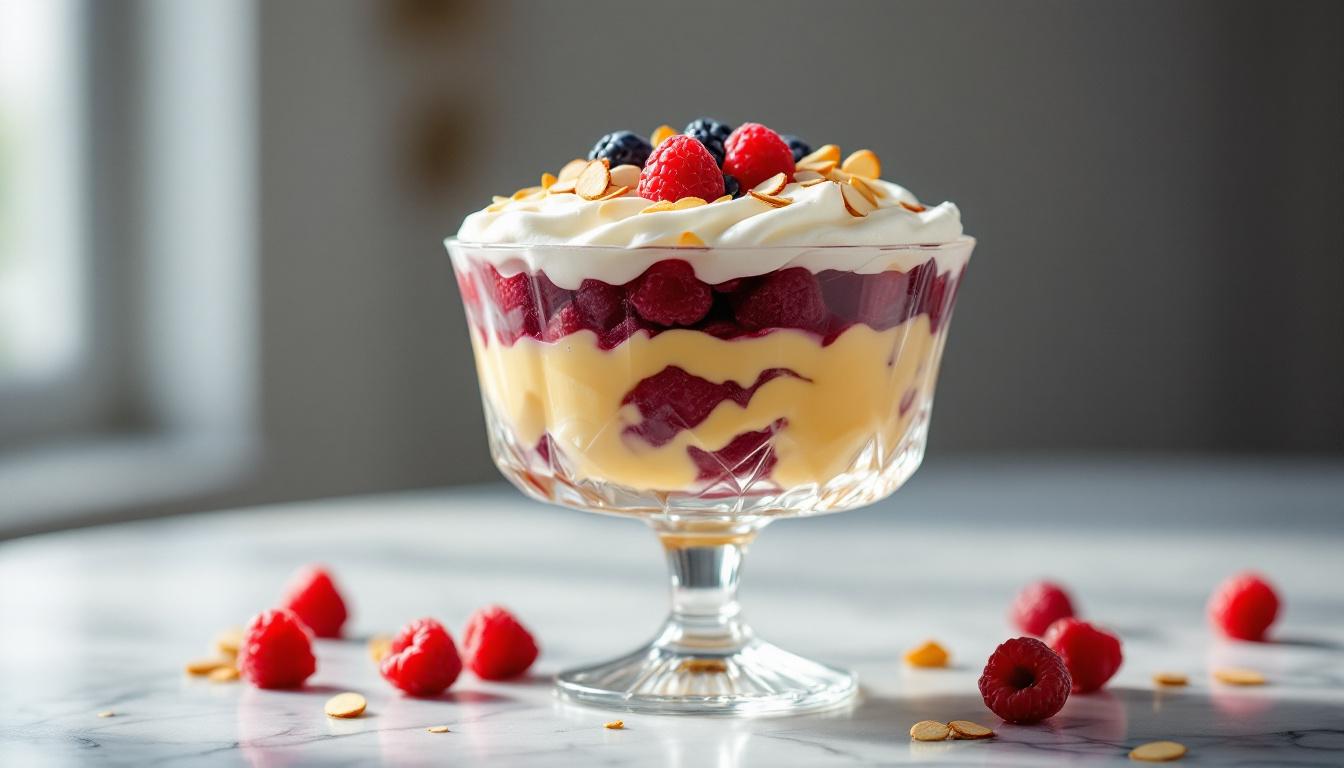Growing up in a restaurant family, I was always fascinated by desserts that tell stories through their layers. The English Berry Trifle does exactly that—each spoonful reveals a carefully orchestrated symphony of textures and flavors. During my apprenticeship at a London bistro, I discovered the secret to an exceptional trifle isn’t fancy ingredients but rather the patient building of perfectly balanced layers. This classic British dessert transforms humble elements into something magnificent when assembled with care and allowed to mature—like all great things in life!
The Story
The English Berry Trifle (or “Trifle anglais aux fruits rouges”) dates back to the 16th century when it began as a clever way to use leftover sponge cake. What started as simple kitchen economy evolved into a celebratory centerpiece dessert that showcases the gorgeous contrast between soft cake, vibrant berries, luxurious custard, and billowing cream. Unlike many desserts that demand immediate consumption, trifle actually improves with time—a true testament to the brilliance of traditional British cookery.
Ingredients Spotlight
For the Base:
• 6 thick slices of sponge cake or ladyfingers
• 1/3 cup (100ml) sweet sherry or ruby port
• 2 tablespoons strawberry jam (optional)
For the Berry Compote:
• 14oz (400g) fresh strawberries, hulled and sliced
• 7oz (200g) fresh raspberries
• 7oz (200g) fresh blackberries
• 1/3 cup (80g) granulated sugar
• Juice of 1 lemon
• 1 tablespoon light brown sugar
For the Custard:
• 2 cups (500ml) whole milk
• 6 egg yolks
• 1/3 cup (80g) granulated sugar
• 3 tablespoons cornstarch
• 1½ teaspoons pure vanilla extract
• 2 tablespoons (30g) unsalted butter
For Assembly:
• 1¾ cups (400ml) heavy cream, whipped to soft peaks
• ¼ cup (60g) sliced almonds, toasted
• Fresh berries for garnish
Step-by-Step Guide
1. Make the Custard (30 minutes)
- Heat milk in a saucepan until steaming but not boiling (185°F/85°C).
- Whisk egg yolks with sugar until pale and ribbony (about 2 minutes).
- Incorporate cornstarch, whisking until no lumps remain.
- Slowly stream hot milk into egg mixture while whisking constantly.
- Return mixture to saucepan and cook over medium-low heat, stirring continuously until thickened (about 5-7 minutes or until reaching 175°F/80°C).
- Remove from heat, stir in vanilla and butter until smooth.
- Transfer to a bowl, cover with plastic wrap directly touching the surface, and cool completely.
2. Prepare Berry Compote (20 minutes)
- Combine berries, granulated sugar, and lemon juice in a saucepan.
- Simmer gently for 10-15 minutes until berries release their juices but still maintain some structure.
- Stir in brown sugar (which adds depth) and cool completely.
3. Assemble the Trifle
- Layer one-third of the sponge cake in the bottom of a glass trifle bowl.
- Drizzle with one-third of the sherry and spread with jam if using.
- Spoon one-third of the berry compote over the cake layer.
- Pour one-third of the custard over the berries.
- Repeat layering twice more to create three complete sets of layers.
- Top with whipped cream, creating decorative swirls.
- Garnish with toasted almonds and fresh berries.
- Refrigerate for at least 4 hours, preferably overnight.
Expert Techniques
The success of a trifle lies in its layers, and each component deserves attention:
- The custard technique: For silky-smooth custard, strain it through a fine-mesh sieve after cooking. This extra step removes any accidentally curdled bits and creates that luxurious, velvety texture you find in professional crème brûlée.
- The moisture balance: The cake should be moistened but not soggy. I use the “three-second pour” rule—drizzle sherry and count to three, then stop. This prevents the cake from becoming waterlogged while ensuring flavor infusion.
- The cooling discipline: Every component must be completely cooled before assembly. Like the technique used for perfect soufflés, patience is non-negotiable.
Chef’s Note: The true magic of trifle happens during its rest period. I’ve found that 24 hours in the refrigerator transforms it from good to extraordinary. The flavors meld, the cake absorbs the fruit juices, and the custard slightly firms up—much like how a proper brioche needs time to develop its character.
Presentation & Pairing Ideas
Serve your trifle in a clear glass bowl to showcase its beautiful layers—this visual appeal is half the pleasure! For individual servings, portion into glass tumblers or wine glasses for an elegant presentation.
For pairings, I recommend:
- A light, fruity Moscatel sweet wine
- Sparkling Lambrusco whose bubbles cut through the richness
- A classic afternoon tea service with Earl Grey
- For a contemporary twist, a berry-infused gin cocktail
You can adapt this recipe seasonally by using stone fruits in summer or poached pears in autumn. For dietary variations, try enriched cottage cheese whipped with cream for a higher-protein topping, or use gluten-free sponge cake and almond milk custard for an alternative version.
Remember, trifle is forgiving by nature—it welcomes your creativity and personal touch. Make it your own by adding layers of chocolate cake instead of traditional sponge, or introduce unexpected elements like crystallized ginger or orange zest. The beauty of trifle is that it celebrates imperfection and abundance—just like the best moments around the table.
